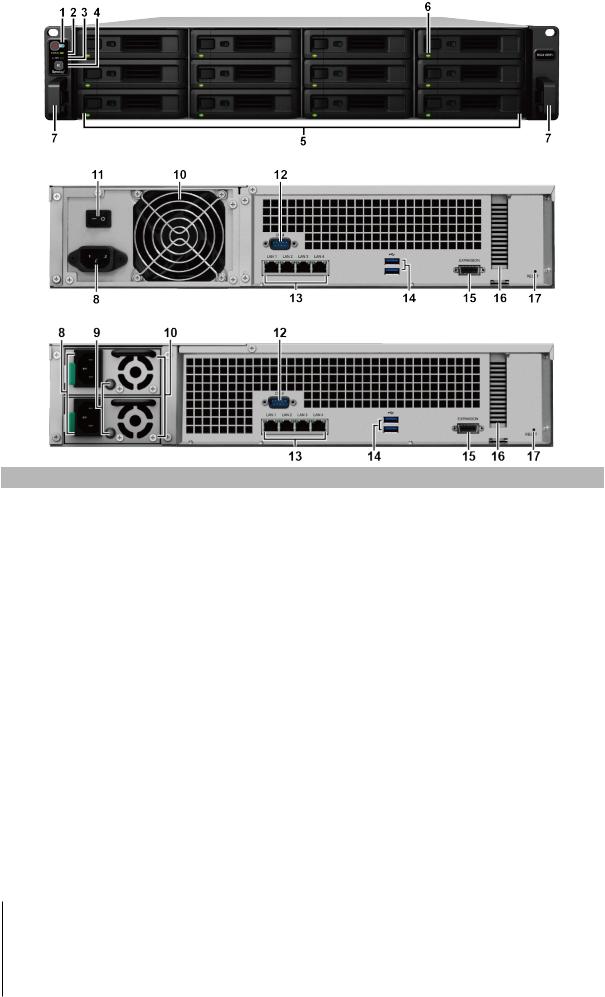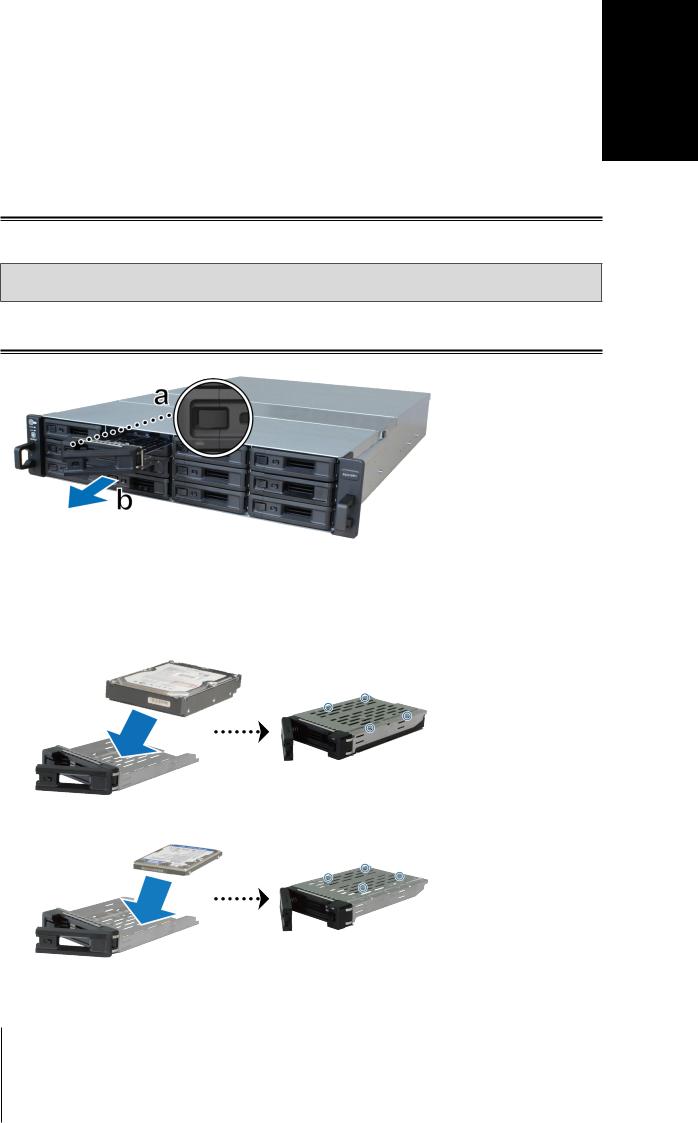Synology RS2418RP+ Manual

Synology RackStation RS2418+/RS2418RP+ 
Hardware Installation Guide

Table of Contents
Chapter 1: Before You Start
Package Contents |
3 |
Synology RackStation at a Glance |
4 |
Safety Instructions |
6 |
Chapter 2: Hardware Setup
Tools and Parts for Drive Installation |
7 |
Install Drives |
7 |
Add a RAM Module on RackStation |
9 |
Attach Network Interface Cards to the RackStation |
12 |
Replace System Fan |
13 |
Replace Redundant PSU1 on RackStation |
14 |
Start Up Your RackStation |
15 |
Chapter 3: Install DSM on RackStation
Install DSM with Web Assistant |
16 |
Learn More |
16 |
Appedix A: Specifications
Appedix B: LED Indicator Table
Synology_HIG_RS2418(RP)+_20170921
2

1Chapter
Before You Start
Thank you for purchasing this Synology product! Before setting up your new RackStation, please check the package contents to verify that you have received the items below. Also, make sure to read the safety instructions carefully to avoid harming yourself or damaging your RackStation.
Note: All images below are for illustrative purposes only, and may differ from the actual product.
Package Contents
Main unit x 1 |
AC power cord1 |
Screws for 2.5” drives x 52
Screws for 3.5” drives x 52
1 AC power cord: RS2418+ x1; RS2418RP+ x2
3

Synology RackStation at a Glance
RS2418+
RS2418RP+
No. |
Article Name |
Location |
Description |
|
|
|
|
|
|
1 |
Power Button and |
|
1. Press to power on the RackStation. |
|
|
2. To power off the RackStation, press and hold until you hear a beep |
|||
Indicator |
|
|||
|
|
sound and the Power LED starts blinking. |
||
|
|
|
||
2 |
Status Indicator |
|
Displays the status of the system. For more information, see "Appendix |
|
|
B: LED Indicator Table". |
|||
|
|
|
||
3 |
Alert Indicator |
|
Displays warnings regarding fan or temperature. For more information, |
|
Front Panel |
see "Appendix B: LED Indicator Table". |
|||
|
|
|||
4 |
Beep Off Button |
Press to deactivate the beeping sound that is emitted when a |
||
|
||||
|
malfunction occurs. |
|||
|
|
|
||
5 |
Drive Tray |
|
Install drives (hard disk drives or solid state drives) here. |
|
|
|
|
|
|
6 |
Drive Status Indicator |
|
Displays the status of drives. For more information, see "Appendix B: |
|
|
LED Indicator Table". |
|||
|
|
|
||
7 |
Rail Kit Release Tab |
|
Push in and hold to release the RackStation from the rail kit lock.1 |
1 For more information about the rail kit installation, please refer to the Quick Installation Guide that comes with the rail kit.
4 Chapter 1: Before You Start

No. |
Article Name |
Location |
Description |
|
|
|
|
8 |
Power Port |
|
Connect power cords here. |
|
|
|
|
|
|
|
1. Displays the status of the power supply unit (PSU). For more |
9 |
PSU Indicator and Beep |
|
information, see "Appendix B: LED Indicator Table". |
Off Button |
|
2. Press to deactivate the beeping sound that is emitted when a |
|
|
|
||
|
|
|
malfunction occurs. |
10 |
PSU Fan |
|
Disposes of excess heat and cools the PSU. |
|
|
|
|
11 |
Power Supply On/Off |
|
Press to turn on/off the power supply. |
Switch |
|
||
|
|
|
|
12 |
Console Port |
|
This port is used for manufacturing use only. |
|
|
|
|
13 |
LAN Port |
Back Panel |
Connect RJ-45 network cables here. |
14 |
USB 3.0 Port |
|
Connect external drives, or other USB devices to the RackStation here. |
|
|
|
|
15 |
Expansion Port |
|
Connect to Synology Expansion Unit2 here. |
16 |
PCI Express |
|
Supports one PCIe x8 slot (x4 link) add-on card. |
Expansion Slot |
|
||
|
|
|
|
|
|
|
1. Press and hold until you hear a beep sound to restore the default IP |
|
|
|
address, DNS server, and password for the admin account. |
17 |
RESET Button |
|
2. Press and hold until you hear a beep sound, then press and hold |
|
again until you hear three beep sounds to return the RackStation |
||
|
|
|
|
|
|
|
to “Not Installed” status so that DiskStation Manager (DSM) can be |
|
|
|
reinstalled. |
2 For more information about Synology Expansion Unit supported by your RackStation, please visit www.synology.com.
5 Chapter 1: Before You Start

Safety Instructions
Keep away from direct sunlight and away from chemicals. Make sure the environment does not experience abrupt changes in temperature or humidity.
Place the product right side up at all times.
Do not place near any liquids.
Before cleaning, unplug the power cord. Wipe with damp paper towels. Do not use chemical or aerosol cleaners.
To prevent the unit from falling over, do not place on carts or any unstable surfaces.
The power cord must plug in to the correct supply voltage. Make sure that the supplied AC voltage is correct and stable.
To remove all electrical current from the device, ensure that all power cords are disconnected from the power source.
Risk of explosion if battery is replaced with an incorrect type. Dispose of used batteries appropriately.
6 Chapter 1: Before You Start

2Chapter
Hardware Setup
Tools and Parts for Drive Installation
•A screwdriver
•At least one 3.5” or 2.5” SATA drive (please visit www.synology.com for compatible drive models.)
Warning: If you install a drive that contains data, the system will format the drive and erase all existing data. Please back up any important data before installation.
Install Drives
1 Open the drive tray.
aFind the small button located on the left side of the drive tray handle. Press the button down, and the drive tray handle will pop out.
bPull the drive tray handle out as illustrated above.
2Install drives:
•For 3.5” drives: Place the drive in the drive tray. Turn the tray upside down and tighten screws into the four spots indicated below to secure the drive.
•For 2.5” drives: Place the drive in the drive tray. Turn the tray upside down and tighten screws into the four spots indicated below to secure the drive.
7

3 Insert the loaded drive tray into the empty drive bay.
Note: Make sure the tray is pushed in all the way. Otherwise, the drive might not be able to function properly.
4Push the handle inward to secure the drive tray.
5Push the switch on the drive tray handle to the left to lock the drive tray.
6Repeat the steps above to assemble the other drives you have prepared.
7Drives are numbered as shown below.
Note: If you want to create a RAID volume, we recommend all installed drives be the same size in order to optimize drive capacity usage.
8 Chapter 2: Hardware Setup
